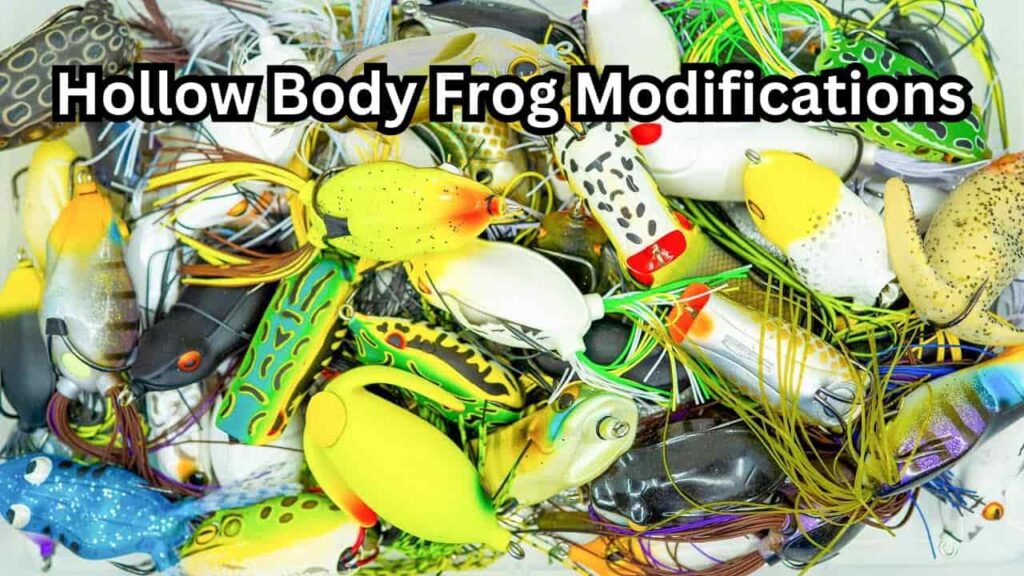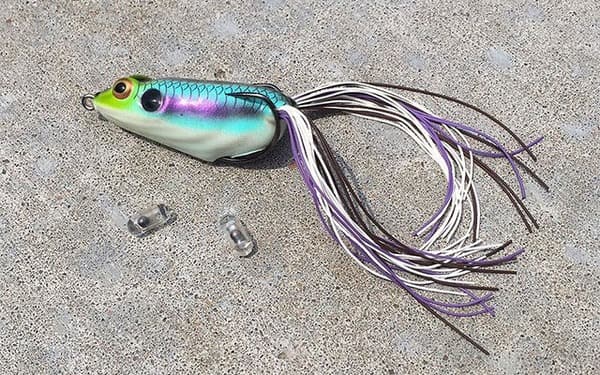5 Hollow Body Frog Modifications to Catch More Bass
Bass anglers rarely use frogs straight out of the box. Most guys will modify them in certain ways to help them catch more bass.
There are a bunch of fancy and wild modifications out there, so let’s keep it simple.
These are the 5 best hollow body frog modifications that will help you catch more bass.
Best Frog Modifications
1. Trim the Legs
You have probably already heard of this one, but it is more of a necessity than a modification.
Straight out of the box, the legs on pretty much all hollow body frogs are way too long.
The long legs cause two main problems. First and foremost, long legs will cause bass to short strike and miss your bait.
Since the legs are so long, bass will grab onto the legs and not get the hooks in their mouth.
This results in a much lower hook up ratio. Secondly, the long legs make it much harder to walk the frog.
They cause too much drag and resistance, which limits how far the frog can bounce to each side.
I honestly don’t know why companies make the legs so long because every single bass fisherman trims them up.
Simply put, if you trim you frog’s legs, you will catch more bass.
How Much to Trim the Legs
I like the legs on my hollow body frogs to be about 2 inches long. But the heavier the cover that I am fishing in, the shorter I make the legs.
This is because the heavier the cover is, the harder it is for bass to accurately attack the lure.
So having shorter legs help them to hone in on the body, and hooks of the bait. But anything 2 inches or less works great.
2. Add Sound
Adding a rattle or bell to your frog will give it some extra sound. All hard-body lures have rattles and beads in them to make sound and attract bass in from farther distances.
Now, you don’t need any specialized rattles. Just take some small plastic beads, mini bells, bead capsules, or anything else that make a little bit of sound and isn’t too heavy.
If the these beads are heavy, they will cause your frog to sink down in the water.
When to Add Sound
You should add sound to your frogs when visibility is low. Murky water, rain, wind, overcast days, morning and evening hours.
All these situations create low visibility in the water and make it harder for bass to find their prey.
So add some sound the the frog to make it easier for them.
3. Plug the Hook Hole
Hollow body frogs do have a couple holes in them that can allow water to get in.
The biggest one is the hole where the hooks come out. Water comes up through this hole and will cause the frog to sit farther and farther in the water each cast, until it eventually goes under.
Now this isn’t a huge problem because you can just squeeze the water out every 5-10 casts.
But there is a frog modification that seals up this hole. I got this tip from Gene Jenson, and he has a great tutorial below.
But essentially, you flip the hooks around the frog, wrap braided line around the hook until you create a hump on the hook.
Than you reset the hook in place. This hump of braided line will plug the hole where the hook exits, and prevent water from getting into your frog.
4. Swap Legs for Blades
Now I will be honest, I pretty much never actually do this. It definitely works, but I just feel like it takes away from the identity of the frog a bit.
But it is a very fun way to fish, and can catch some very aggressive bass. It is very easy to do.
First, you rip out the legs of the frog. Next, you take a spinnerbait blade, whichever you like, and attach it to a barrel swivel.
Then you jam the barrel swivel up into the leg holes. They should stay in place, but I like to add some super glue to fill in the hole and prevent water logging.
This setup is actually one of the most best snakehead lures. But it can definitely catch bass as well, and is worth trying it you are looking for something a bit different.
When to Swap the Legs
In theory, open water is where this setup shines. However, you can use it any of the same places that you would use a traditional frog.
It has more sound, vibration, and flash, so these bladed frogs can be very effective in muddy water, wind, rain, or low light conditions.
5. Bend Out the Hooks
Most frog fisherman will slightly bend out their frog hooks. What this does is angles the hooks a bit farther upward, allowing the hook point to catch the bass’s mouth easier.
This will increase your hook ups by 10-15%. Now the downside to bend up your hooks is that the frog becomes slightly more likely to snag.
However, this is only a problem when fishing scum, cheese, or the really thick, matted vegetation.
Otherwise, the frog float upright and the hooks will still be pointed away from any potential snags.
You don’t want to bend the hooks very much. Just ever so slightly take you pliers and bend the hook up off the frog’s body a tiny bit.
This small bend makes a big difference and will put more bass in the boat.
Bonus Modifications
- Color Up Your Frogs: Feel free to take a sharpie and color up your frog how you like. This is primarily just to have some fun with it, but if you know what colors to use on your frogs, it can also make the bait more effective.
- Super Glue the Weight: The weight on the bottom of a frog can come lose over time. A little bit of super glue will keep it in place and make your frog last longer.
- Sharpie Your Line: You are always going to be using straight braided line when fishing a frog. And braid is very visible to the bass. Take a black or green sharpie and run it across the braided line 1-2 feet in front of the frog. This will decrease the line’s visibility and give more confidence to interested bass.
Reeling this In
In summary, modifying your hollow body frog by trimming the legs, adding sound in low visibility, and plugging the hook hole can boost your bass fishing success.
Optional changes like swapping legs for blades and bending out hooks can also be effective.
Don’t forget the bonus tips for further optimization. These modifications enhance your setup, improve hook-ups, and make your fishing trips more rewarding.












